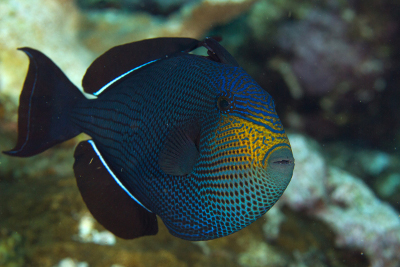Black Finned Triggerfish
Category: Salt Water

Facts about Black Finned Triggerfish, "Scientific name for Black Finned Triggerfish is Melichthys niger". The Black Finned triggerfish is also called the Hawaiian Black Triggerfish, or the Indian Triggerfish. In Pacific books and records, the fish is also known as M. radula and M. buniva. The Black Finned Triggerfish body often tend to vary in color: when in the wild the body appears black. However, when out of water, the Black Finned Triggerfish body’s color tend to change in somehow dark blue to blue-green, or even in some cases brown featuring a few bold white lines around the base of the anal and dorsal fins. Around its face are thin, light blue-turquoise lines. The Black finned triggerfish slightly differs from other triggers, which normally live solitary lives on the reef. Each of the black finned triggerfish has its own niche among the rock and coral formations outside the reefs. And, from time to time, they do emerge and converge near the water surface in a huge school to feed on the zooplankton and algae been drifted by water currents.
Black finned triggerfish is often seen to attack and bite other tankmates when put together in a single tank. They are actually not community types and should not be placed in a closed environment with others of its kind. When the Black Finned Triggerfish are in the wild, they would simply run away from one another when such aggression arises. A 90 gallons or bigger aquarium is recommended for the Black Finned Triggerfish species. The temperature of the tank condition should range between 72 to 78F with a pH range of 8.0 to 8.5. the fish feeds on a variety of meaty foods such as krill, squid, small fish, shelled shrimp, and clams.
Aquarium care of Black Finned Triggerfish
Test the water when preparing your tank for your Black Finned Triggerfish: You will need to purchase a liquid tester so that you can test for Nitrates and Ammonia. The strip-style test kits are unreliable and a waste of money. You should use a dechlorinating product to remove the harmful chlorine from the water. Test for nitrite, ammonia, and proper PH. The ammonia should always be 0, the nitrite should be 0, and the nitrate should preferably be below 20 ppm. If it's at or above 40 parts per million (ppm), you have too many fish or are not changing the water often enough. Cycling your tank is important, Follow the steps to cycle your tank. This establishes healthy bacterial and chemical levels.
When buying your Black Finned Triggerfish see which one looks like the healthier fish in the tank. Be wary of tanks with dead fish in them, as this can be a sign of illness or improper care. Clamped fins are a sign of illness. In addition, healthy Black Finned Triggerfish will have no white spots, make sure they swim with their fins held upright, and have a nice rich color or colors. Make sure the Black Finned Triggerfish swim all over the tank and look healthy.
When adding the Black Finned Triggerfish to the aquarium, it is important to introduce the fish to the tank environment slowly. As soon as you get home, float the entire, closed pet store bag (with the Black Finned Triggerfish inside!) in the tank on top of the water for about a half hour. This will allow the water in the plastic bag and the Black Finned Triggerfish to equalize out to the same temperature as in your tank, so your Black Finned Triggerfish does not get shocked by the different temperature. Next, add a small amount of water from your tank to the bag, and wait about 15 minutes. Do this at least one more time. Us a net to catch your Black Finned Triggerfish and then while the fish is in the net, dispose of all the water down a drain or outside. Then transfer the Black Finned Triggerfish carefully into the your tank. This process not only reduces stress for you fish, it also prevents the dirty pet store water from contaminating your tank with disease.
Remove 30% of the water from you Black Finned Triggerfish tank each month with new water, or a 15% water change every 2 weeks is ideal for keeping nitrates lower. With corals in the Black Finned Triggerfish tank, then 20% water change every month, or 10% change every 2 weeks.
Black Finned Triggerfish are omnivore, (definition-they eat both other animals and plants).

 Back To Category Salt Water
Back To Category Salt Water